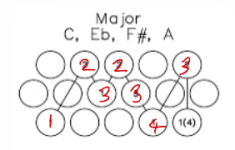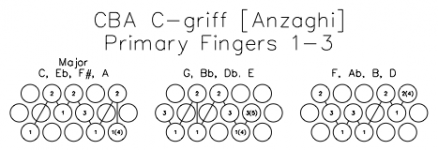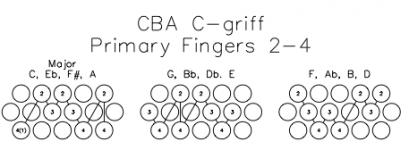Reading the above it's clear we all take different approaches and all are valid. For myself I've just found starting with 5 rows immediately has been the right way to make rapid progress and feel almost as comfortable with the CBA in a short time as I do with a piano keyboard. We all learn in different ways though and there's no one size fits all. Most important investment I'd say is a really (and I mean really) good teacher who is at the top of their game: then it's down to time and dedication.
You are using an out of date browser. It may not display this or other websites correctly.
You should upgrade or use an alternative browser.
You should upgrade or use an alternative browser.
C-system fingering. Scales.
- Thread starter Chrisrayner
- Start date
- Status
- Not open for further replies.
Oh no, I'm "last post of the previous paged!"
Doom!
Doom!
Thanks Lost, Saunders, Tom! Yup, different strokes for different folks, but it's all useful. In my experience, unfortunately, "finding a good teacher" is right up there with "finding a good repair person," kind of like the holy grail.
No no no!! It’s C, F, and G.?
I agree otherwise. I have both 4 and 5 row instruments. I tend to stick to the outer four rows, with a prejudice in favour of the outer three, although in some tunes buttons in rows four and five make life much easier. I also do an exercise using fingers only playing major and minor arpeggios ascending and descending, so CEGC, EGCE, GCEG, and so on, then back down. Then with Eb.
I agree otherwise. I have both 4 and 5 row instruments. I tend to stick to the outer four rows, with a prejudice in favour of the outer three, although in some tunes buttons in rows four and five make life much easier. I also do an exercise using fingers only playing major and minor arpeggios ascending and descending, so CEGC, EGCE, GCEG, and so on, then back down. Then with Eb.
The CBA right hand for me is all about choices. I'm not sure about comparing with piano or piano accordion.
A recent post asked about fingering for Eminor 'Indifférence'
Zevy (I think) said Murena played in Fminor and was for once pleased he played PA.
Four flats and the Trio in Aflat - you'd need to be mad.
Except Fminor on the CBA sits happily on the outer 3 rows.
Moral: It may well be worth considering another key if a tune does not sit easily in the key suggested.
A recent post asked about fingering for Eminor 'Indifférence'
Zevy (I think) said Murena played in Fminor and was for once pleased he played PA.
Four flats and the Trio in Aflat - you'd need to be mad.
Except Fminor on the CBA sits happily on the outer 3 rows.
Moral: It may well be worth considering another key if a tune does not sit easily in the key suggested.
So (in theory) on CBA you just say, "if I was going there, I wouldn't start on this button!"Moral: It may well be worth considering another key if a tune does not sit easily in the key suggested.
bgilesuk
Member
Reading the above it's clear we all take different approaches and all are valid. For myself I've just found starting with 5 rows immediately has been the right way to make rapid progress and feel almost as comfortable with the CBA in a short time as I do with a piano keyboard. We all learn in different ways though and there's no one size fits all. Most important investment I'd say is a really (and I mean really) good teacher who is at the top of their game: then it's down to time and dedication.
I'm going to stick to how I was taught 25 years ago, i.e. initially learning all scales using just the first 3 rows, then adding keys in rows 4 & 5 when it simplifies the passage in the music. Using Ben's fingering, I now have an alternative to the fingering I was taught with, providing more options.
I believe that learning this way ultimately makes it easier to 'sight read' music, then tweak it using alternative rows.
It would be nice to have some professional teachers views on this topic, highlighting why most usually restrict the student to initially using the first 3 rows.
Brian
Ok, I think I get it. You can use this pattern in all keys by starting with "Do" on any note on the first three rows, using rows 1,2,3 2,3,4 or 3,4,5, depending which row you start on. You're not really making a scale using all 5 rows. This could come in handy for, for example, keeping your thumb on the root for chording. Using the other 2 patterns gives you additional scale possibilities, and certainly is needed for a 3 row cordeen.
bgilesuk
Member
Hi Tom, look at my post dated 31st March, where I've shown 2 alternatives for all the Major scales, using just the first 3 rows.Ok, I think I get it. You can use this pattern in all keys by starting with "Do" on any note on the first three rows, using rows 1,2,3 2,3,4 or 3,4,5, depending which row you start on. You're not really making a scale using all 5 rows. This could come in handy for, for example, keeping your thumb on the root for chording. Using the other 2 patterns gives you additional scale possibilities, and certainly is needed for a 3 row cordeen.
The first concentrates on using fingers 1-3, the other, which Ben uses, concentrates on using fingers 2-4.
I'm now learning the latter, in the hope it will expand my options.
Once you have these 3 patterns, irrespective of which fingering method used, you can then progress up a scale (from a chord, for example) from any row, assuming you have 5 at your disposal.
Brian
Last edited:
Ok, this one, thanks Brian! I'm at a point of trying out the different fingerings. This is a good reference.
Thanks, Tom
Ben, I really appreciate your explanation of how you get around the CBA keyboard. Having learned music on the oboe, I'm not used to having so many options for fingering, and get confused by it more easily than most people. I'm using mostly fingers 2, 3, and 4 now, and thinking about it less. It's working well for me.Interesting discussion as it made me write down how I get around the CBA keyboard which I 'knew' but hadn't ever explained until I was forced to write it down! I was terrified of it at first being a life long pianist/organist however I now see how much more simple it is. I guess it depends how your brain is wired...mine looks for consistent principles rather than rules so if i'm working something out it is on the basis of the principles I outlined above rather than a zillion different scales.
But I still think about accordion fingering when I'm not playing
As I see it, there are four things that one can learn by practicing scales on the accordion.
1. Locations of notes
2. Patterns of intervals
3. Fingering techniques or gestures
4. Principles for fingering
It is a huge mistake to practice scales only as a series of gestures and commit them to "muscle memory." I did that when learning a major scale on the Stradella system. If I'd practiced it in every key, saying the note names, or reading from sheet music, I might have learned the layout of the counterbass row, and improved my ability to read bass clef. If I had practiced playing the scale degrees out of order while listening to the intervals, I might have improved my ability to play bass melodies by ear. But I didn't do those things, so all I learned was how to play a major scale or part of a scale, starting at the root.
I've found it helpful to practice exercises that separate these elements (Jean Yves-Sixt has several videos) so I can visualize and find the scale and chord patterns independent of the fingers and hand movements used. It's a mistake to think that your fingers should fall into the same fingering patterns every time you run across a scale fragment, chord or arpeggio in the music. For the jig I'm working on this week, I can play with better rhythm if I switch between 123, 234, and 134 for major arpeggios, depending on what comes before or after.
Small gestures found in printed scale fingerings can be helpful in other contexts. I did not know you could cross 2 over 3, 2 over 4, or 3 over 2 until I encountered them in books.
My problem with method books is not lack of consistency or proliferation of options. The CBA allows for many alternatives and it's worth learning a few to apply to different situations. My problem is that they rarely explain the purpose of the exercise, or the logic behind the fingering
I'd agree with you that often the reason behind fingering is rarely explained in books. In their defence I guess often its hard to put it into succinct language.My problem with method books is not lack of consistency or proliferation of options. The CBA allows for many alternatives and it's worth learning a few to apply to different situations. My problem is that they rarely explain the purpose of the exercise, or the logic behind the fingering
My test of good fingering is that:
- it needs to avoid putting any tension in your hand especially across your palm/in between fingers
- you can play it consistently really fast and really slow
- it feels natural i.e. it doesn't need massive amounts of practice to achieve some strange contortion or over thinking
- it never goes wrong i.e. often I've found that fingering I've had to practice loads to achieve consistency is suspect and under pressure it fails, so its time to think again for something that is bomb proof and easy
In the few lessons I've had from really world class players we've never done any scales or used the various scale fingerings as an approach to real music (which initially surprised me) but rather looked at principles of good fingering on a 5 row e.g:
- as far as possible always use same/consistent fingering for same pattern/sequence of notes in a piece of music irrespective of the pitch they sound
- when a note is repeated, always use a fresh finger on it for clean articulation and to get your hand ready for the next passage. This is the most valuable thing I have ever learnt for 5 row fingering and use it for all music from french musette tunes to folk to pop music to Scarlatti.
- its got to feel comfortable and natural in terms of the way your hand works
As I said before I think personally its better to think in principles of good fingering rather than systems (scales) of good fingering. In other words, asking the right question first: 'What are the principles of good fingering?' rather than 'What scale systems are there for a 5 row?'
For me (as someone that has played piano/organ on inconsistent black and white rows etc for decades) scale systems really help you with real music on this sort of keyboard. Conversely for a 5 row consistent keyboard its the principles of good fingering that you need to think in and not to relate it to instruments where scale systems are invaluable.
Otherwise you are trying to play football using the rules of cricket which would cause anyone anxiety!
Apart from the one fingering pattern to cover all scales mentioned earlier, I personally wouldn't worry about scales any further. Thinking in principles really makes the 5 row make sense as its surely behind the thinking of the brain that invented such an amazing keyboard for music making where the keyboard sits on a vertical plane.
- Status
- Not open for further replies.
Similar threads
- Replies
- 16
- Views
- 3,206
- Replies
- 7
- Views
- 500
- Replies
- 11
- Views
- 4,416
- Replies
- 9
- Views
- 2,843



